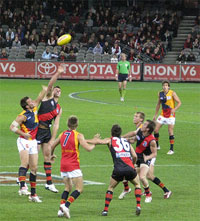

Low Down on Aussie Rules
Joe Burton provides an overview of the rules and principles of Australian Football, its history, and the health benefits of playing it.
Australian Rules Football is a sport that only gets played Down Under. In recent years, there have been some inroads to try to grow the game's fan base and participation in other countries. The success has been minimal, but hopefully, the game will start to gain relevance and a following in the years to come.
Rules and objectives of the game
The pitch and the ball in Aussie Rules are oval-shaped, while neither side can have more than nine players on the field at any given time. In essence, the game is an amalgamation of rugby and football. Players can play the ball in any direction.
It can be done by kicking, a clenched fist (known as a handball), or an open-hand tap. However, throwing the ball is strictly outlawed, and anyone who does it will concede a free-kick. Once you have possession, you can only dispose of it by kicking or punching.
Participants may run with the ball only if it touches the floor or bounces once every 15 seconds. Defenders can bump and tackle the attacking players, but an aggressive tackle aimed at an opponent's back will warrant a penalty.
The scoring can seem complex. A goal worth six points has to go through the central goalposts by way of a kick. It does not matter if it bounces on the way and trickles over the line. It will still count, but if an opposition player touches the ball, then the goal will not count. You can also amass points via a behind. It happens when you kick the ball through the two other goalposts on either side of the central posts. The game comprises four 20-minute quarters, with a half-time after two quarters. Like most team sports, the winner scores the most points. If the scores are tied, then the game is called a draw. |
 |
The AFL
The Australian Football League (AFL), the premier Aussie Rules division, can trace its roots back to the Victorian Football League, founded in 1897. After the Victorian League was expanded to other states in the 1980s, it changed its name to encompass the new national element of the game, renaming itself the AFL in 1990.
Carlton and Essendon are the two most successful sides, with 16 Premierships each. At the same time, Hawthorn is the current defending champion and is the current favourite to land the much-coveted Championship this time around in sports betting.
Similar to American sports, the AFL has a league and playoff format. The top eight teams in the division go through to the final series, which functions in a straight knockout scenario. If your team is fortunate enough to make it to the final, they will play at the legendary Melbourne Cricket Ground.
This stadium has a staggering capacity of 100,000 and is called the “Spiritual Home of Australian Sport”; playing there is a momentous occasion for any Aussie Rules player.
Again, like America, the league also has an MVP award. The Brownlow Medal is given to the best player in the league, with the current MVP being Matt Priddis of the West Coast Eagles.
Health Benefits
As previously mentioned, Aussie Rules is a combination of football and rugby and hence involves a significant amount of running. The average AFL player runs between 12 and 13km per game. Nathan Buckley, who spent most of his career with Collingwood before retiring, once ran 19km in a game.
The average in the Premier League, England's top-flight football division, is usually beneath 10km, and in rugby union, it is not generally higher than 7km. Already, you can see that Aussie Rules is the best sport for cardio exercise. The distance these players cover per game is a testament to their natural fitness, not to mention the enduring nature of the game.
It is not just running through. Tackling other players takes its toll on the body. Driving your shoulder into someone at high speed will only strengthen the muscles. The same goes for the abdomen, while the muscles in your legs, which are already being worked hard, will also enlarge as they aid in tackling.
Being a high-impact contact sport, your body will get pretty battered. It will usually just be bruised, but you can pick up a severe injury on the rare occasion. But that said, is that not the same for all sports? In the grand scheme of things, football looks safe.
Still, when you factor in the number of players who injured their knees, the medial collateral ligament (MCL) injury is one of the most common with footballers - you soon realise that even a benign sport can have serious repercussions.
Page Reference
If you quote information from this page in your work, then the reference for this page is:
- BURTON, J. (2015) Low Down on Aussie Rules [WWW] Available from: https://www.brianmac.co.uk/articles/article182.htm [Accessed
About the Author
Joe Burton is a sports enthusiast. After emigrating from the UK to Australia, he decided to swap football for Aussie Rules and has not looked back. Besides playing a sport, Joe works as a freelance journalist, mainly covering European sports, so he still links his footballing past. As an avid fan of Liverpool FC, Melbourne City, and St Kilda, you would not think he would have time to be a family man, yet somehow, he manages.